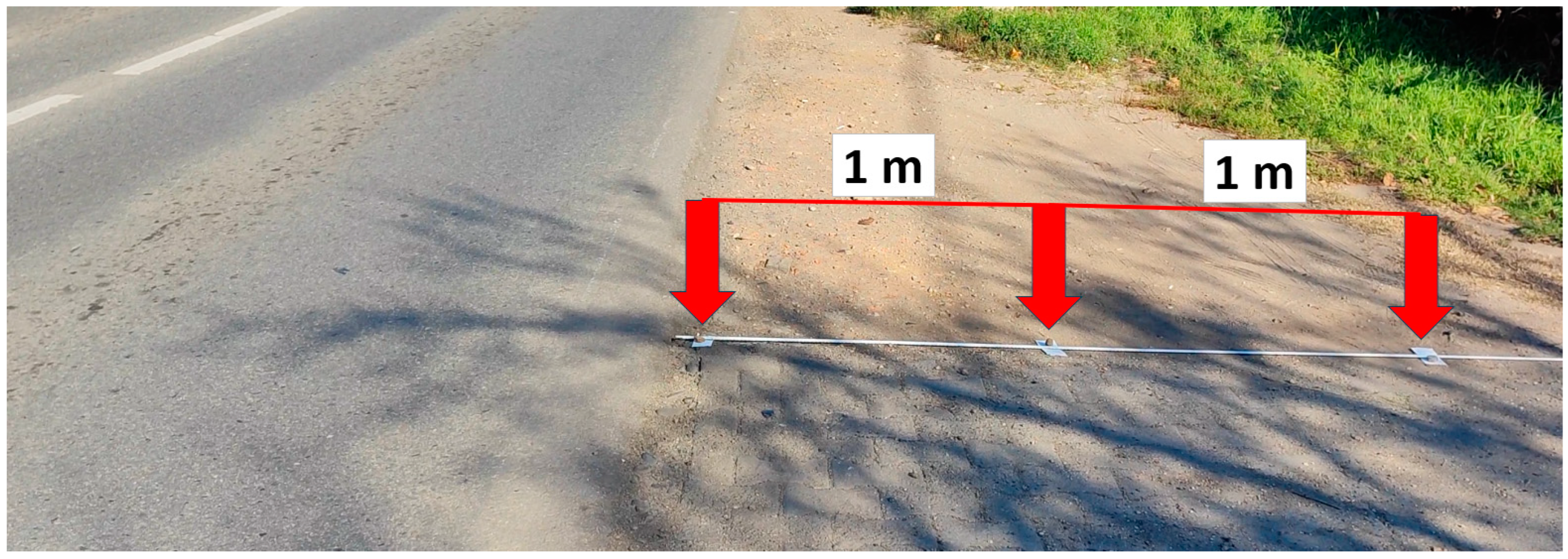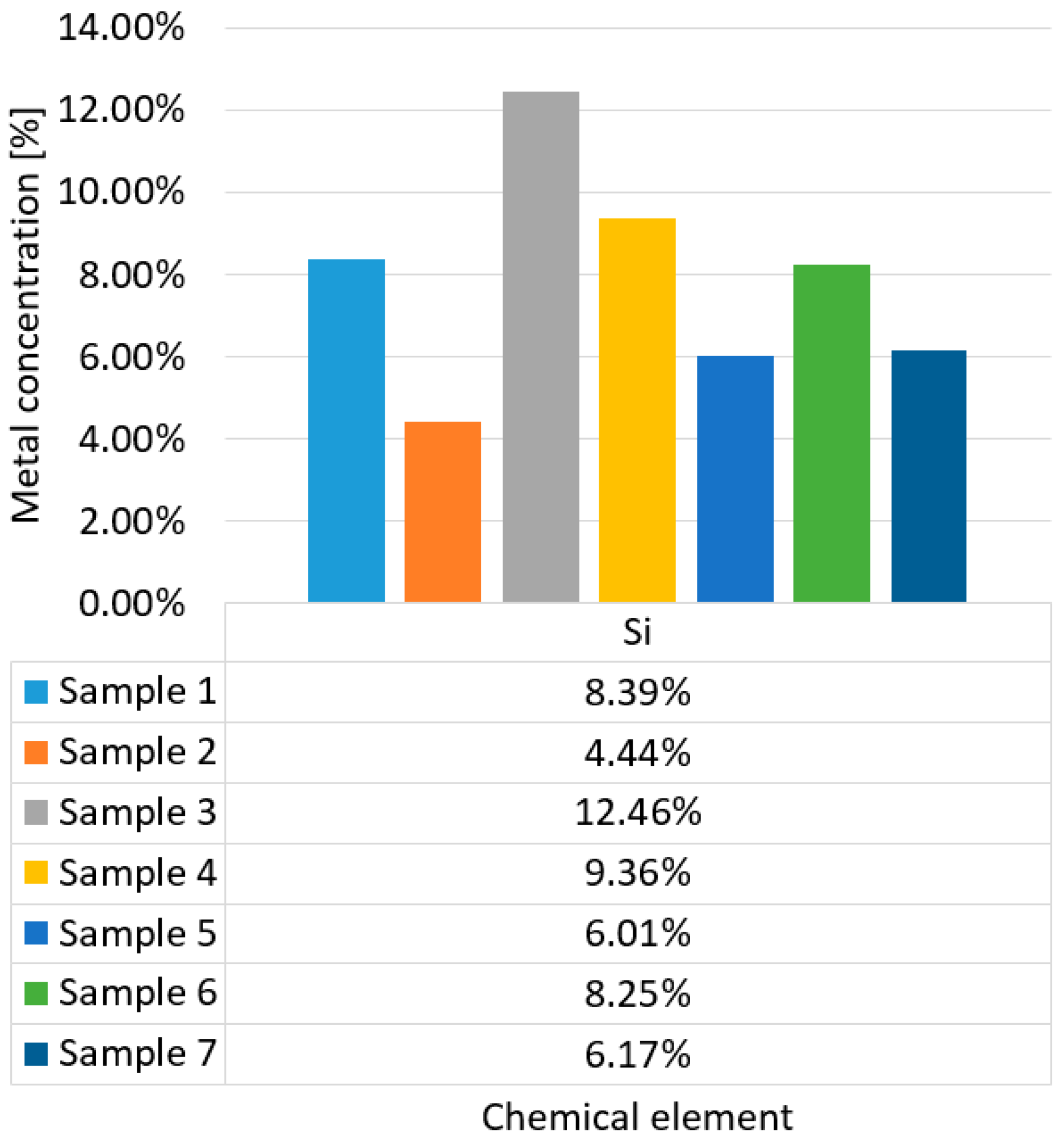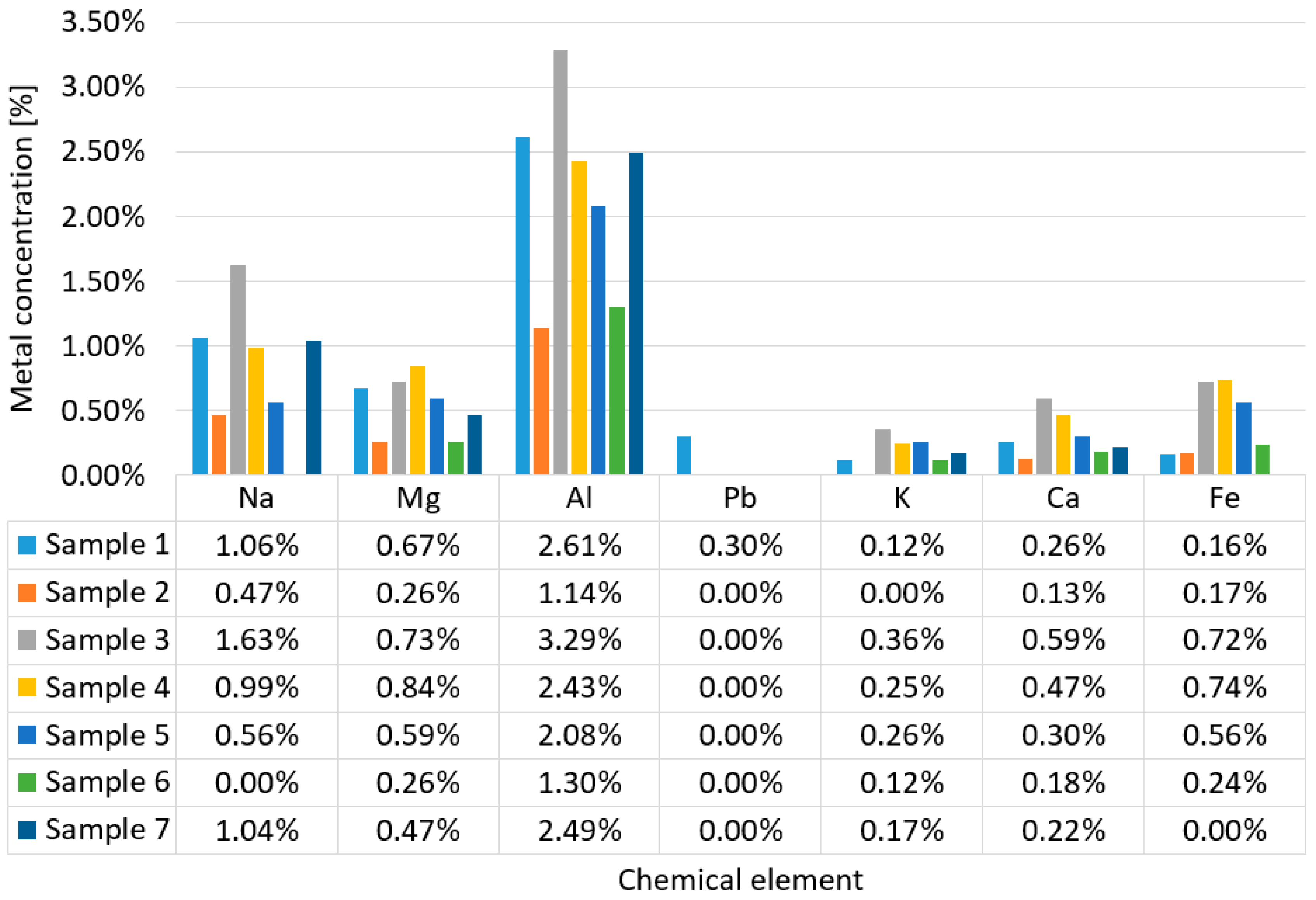Metal Element Traces Sampled from Peri-Urban Road Verge Particulate Matter
Abstract
:1. Introduction
1.1. Particulate Matter Generation and Its Effects upon Human Health
1.2. Presence of Metals in Particulate Matter and Their Negative Impact on Human Health
1.3. Objectives of the Research Study
2. Materials and Methods
3. Results and Discussion
3.1. Determination of Metal Concentrations from Dust Samples
3.2. Determination of PM Concentrations Using DLS Spectrometer
4. Conclusions
Author Contributions
Funding
Data Availability Statement
Conflicts of Interest
References
- Thorpe, A.; Harrison, R.M. Sources and proprieties of non-exhaust particulate matter from road traffic: A review. Sci. Total Environ. 2008, 400, 270–282. [Google Scholar] [CrossRef]
- Harrison, R.M.; Beddows, D.C. Efficacy of Recent Emissions Controls on Road Vehicles in Europe and Implications for Public Health. Sci. Rep. 2017, 7, 1152. [Google Scholar] [CrossRef]
- Pant, P.; Harrison, R.M. Estimation of the contribution of road traffic emissions to particulate matter concentrations from field measurements: A review. Atmos. Environ. 2013, 77, 78–97. [Google Scholar] [CrossRef]
- OECD-iLibrary. Available online: https://www.oecd.org/environment/non-exhaust-particulate-emissions-from-road-transport-4a4dc6ca-en.htm (accessed on 20 May 2023).
- Harrison, R.M.; Allan, J.; Carruthers, D.; Heal, M.R.; Lewis, A.C.; Marner, B.; Murrells, T.; Williams, A. Non-exhaust vehicle emissions of particulate matter and VOC from road traffic: A review. Atmos. Environ. 2021, 262, 118592. [Google Scholar] [CrossRef]
- Celo, V.; Yassine, M.M.; Dabek-Zlotorzynska, E. Insights into Elemental Composition and Sources of Fine and Coarse Particulate Matter in Dense Traffic Areas in Toronto and Vancouver, Canada. Toxics 2021, 9, 264. [Google Scholar] [CrossRef]
- Badaloni, C.; Cesaroni, G.; Cerza, F.; Davoli, M.; Brunekreef, B.; Forastiere, F. Effects of long-term exposure to particulate matter and metal components on mortality in the Rome longitudinal study. Environ. Int. 2017, 109, 146–154. [Google Scholar] [CrossRef]
- Eeftens, M.; Hoek, G.; Gruzieva, O.; Mölter, A.; Agius, R.; Beelen, R.; Brunekreef, B.; Custovic, A.; Cyrys, J.; Fuertes, E.; et al. Elemental Composition of Particulate Matter and the Association with Lung Function. Epidemiology 2014, 25, 648–657. [Google Scholar] [CrossRef] [PubMed]
- Thomson, E.M.; Breznan, D.; Karthikeyan, S.; MacKinnon-Roy, C.; Charland, J.-P.; Dabek-Zlotorzynska, E.; Celo, V.; Kumarathasan, P.; Brook, J.R.; Vincent, R. Cytotoxic and inflammatory potential of size-fractionated particulate matter collected repeatedly within a small urban area. Part. Fibre Toxicol. 2015, 12, 24. [Google Scholar] [CrossRef] [PubMed]
- Garg, B.D.; Cadle, S.H.; Mulawa, P.A.; Groblicki, P.J.; Laroo, C.; Parr, G.A. Brake Wear Particulate Matter Emissions. Environ. Sci. Technol. 2000, 34, 4463–4469. [Google Scholar] [CrossRef]
- Sanders, P.G.; Xu, N.; Dalka, T.M.; Maricq, M.M. Airborne brake wear debris: Size distributions, composition, and a comparison of dynamometer and vehicle tests. Environ. Sci. Technol. 2003, 37, 4060–4069. [Google Scholar] [CrossRef]
- Mosleh, M.; Blau, P.J.; Dumitrescu, D. Characteristics and morphology of wear particles from laboratory testing of disk brake materials. Wear 2004, 256, 1128–1134. [Google Scholar] [CrossRef]
- Rødland, E.S.; Lind, O.C.; Reid, M.J.; Heier, L.S.; Okoffo, E.D.; Rauert, C.; Thomas, K.V.; Meland, S. Occurrence of tire and road wear particles in urban and peri-urban snowbanks, and their potential environmental implications. Sci. Total Environ. 2022, 824, 153785. [Google Scholar] [CrossRef]
- Kukutschová, J.; Moravec, P.; Tomášek, V.; Matějka, V.; Smolík, J.; Schwarz, J.; Seidlerová, J.; Šafářová, K.; Filip, P. On airborne nano/micro-sized wear particles released from low-metallic automotive brakes. Environ. Pollut. 2011, 159, 998–1006. [Google Scholar] [CrossRef] [PubMed]
- Harrison, R.M.; Jones, A.M.; Gietl, J.; Yin, J.; Green, D.C. Estimation of the contributions of brake dust, tire wear, and resuspension to nonexhaust traffic particles derived from atmospheric measurements. Environ. Sci. Technol. 2012, 46, 6523–6529. [Google Scholar] [CrossRef] [PubMed]
- Kumar, P.; Pirjola, L.; Ketzel, M.; Harrison, R.M. Nanoparticle emissions from 11 non-vehicle exhaust sources—A review. Atmos. Environ. 2013, 67, 252–277. [Google Scholar] [CrossRef]
- Woo, S.-H.; Jang, H.; Lee, S.-B.; Lee, S. Comparison of total PM emissions emitted from electric and internal combustion engine vehicles: An experimental analysis. Sci. Total Environ. 2022, 842, 156961. [Google Scholar] [CrossRef]
- Liu, T.; Wang, X.; Deng, W.; Zhang, Y.; Chu, B.; Ding, X.; Hu, Q.; He, H.; Hao, J. Role of ammonia in forming secondary aerosols from gasoline vehicle exhaust. Sci. China Chem. 2015, 58, 1377–1384. [Google Scholar] [CrossRef]
- Wu, D.; Ding, X.; Li, Q.; Sun, J.; Huang, C.; Yao, L.; Wang, X.; Ye, X.; Chen, Y.; He, H.; et al. Pollutants emitted from typical Chinese vessels: Potential contributions to ozone and secondary organic aerosols. J. Clean. Prod. 2019, 238, 117862. [Google Scholar] [CrossRef]
- Denny, M.; Baskaran, M.; Burdick, S.; Tummala, C.; Dittrich, T. Investigation of pollutant metals in road dust in a post-industrial city: Case study from Detroit, Michigan. Front. Environ. Sci. 2022, 10, 1431. [Google Scholar] [CrossRef]
- Apeagyei, E.; Bank, M.S.; Spengler, J.D. Distribution of heavy metals in road dust along an urban-rural gradient in Massachusetts. Atmos. Environ. 2011, 45, 2310–2323. [Google Scholar] [CrossRef]
- Aguilera, A.; Cortés, J.L.; Delgado, C.; Aguilar, Y.; Aguilar, D.; Cejudo, R.; Quintana, P.; Goguitchaichvili, A.; Bautista, F. Heavy Metal Contamination (Cu, Pb, Zn, Fe, and Mn) in Urban Dust and its Possible Ecological and Human Health Risk in Mexican Cities. Front. Environ. Sci. 2022, 10, 195. [Google Scholar] [CrossRef]
- Coll Decree of the Ministry of Agriculture, Environment and Regional Development of the Slovak Republic, Which Lays Down Requirements for Fuel Quality and Keeping Operational Records on Fuels. Available online: https://www.slov-lex.sk/pravne-predpisy/SK/ZZ/2010/362/vyhlasene_znenie.html (accessed on 16 August 2023).
- Shi, G.; Chen, Z.; Xu, S.; Zhang, J.; Wang, L.; Bi, C.; Teng, J. Potentially toxic metal contamination of urban soils and roadside dust in Shanghai, China. Environ. Pollut. 2008, 156, 251–260. [Google Scholar] [CrossRef] [PubMed]
- American Chemical Society. U.S. Synthetic Rubber Program—National Historic Chemical Landmark. Available online: https://www.acs.org/content/acs/en/education/whatischemistry/landmarks/syntheticrubber.html (accessed on 16 August 2023).
- NIOSH, National Institute of Occupational Safety and Health. Manual of Analytical Methods; Method 7602, Silica Crystalline, 5th ed.; NIOSH: Washington, DC, USA, 1994.
- Steenland, K.; Mannetje, A.; Boffetta, P.; Stayner, L.; Attfield, M.; Chen, J.; Dosemeci, M.; DeKlerk, N.; Hnizdo, E.; Koskela, R.; et al. Pooled exposure–response analyses and risk assessment for lung cancer in 10 cohorts of silica-exposed workers: An IARC multicentre study. Cancer Causes Control. 2001, 12, 773–784. [Google Scholar] [CrossRef]
- Background Document for Silica, Crystalline (Respirable Size). Report on Carcinogens; U.S. Department of Health and Human Services, Public Health Services, National Toxicology Program: Research Triangle Park, NC, USA, 1998. Available online: https://ntp.niehs.nih.gov/ntp/newhomeroc/other_background/silica_no_app_508.pdf (accessed on 17 August 2023).
- Adeyanju, E.; Okeke, C.A. Exposure effect to cement dust pollution: A mini review. SN Appl. Sci. 2019, 1, 1572. [Google Scholar] [CrossRef]
- Mustață, D.-M.; Ionel, I.; Popa, R.-M.; Dughir, C.; Bisorca, D. A Study on Particulate Matter from an Area with High Traffic Intensity. Appl. Sci. 2023, 13, 8824. [Google Scholar] [CrossRef]
- Horiba. Available online: https://www.horiba.com/gbr/scientific/technologies/dynamic-light-scattering-dls-particle-size-distribution-analysis/dynamic-light-scattering-dls-particle-size-distribution-analysis/#:~:text=Particle%20size%20can%20be%20determined,elastic%20light%20scattering%20(QELS) (accessed on 30 August 2023).
- Singh, S.K.; Singh, R.K.; Singh, K.K.; Singh, S. Concentration, sources and health effects of silica in ambient respirable dust of Jharia Coalfields Region, India. Environ. Sci. Eur. 2022, 34, 68. [Google Scholar] [CrossRef]
- Meteo Blue. Available online: https://www.meteoblue.com/ro/vreme/archive/export/dumbr%c4%83vi%c8%9ba_rom%c3%a2nia_678688?fcstlength=1m&year=2023&month=7 (accessed on 30 August 2023).
- Romanian Law no. 104 from 15 June 2011 in Relation to Air Quality (Original in Romanian: LEGE nr. 104 Din 15 Iunie 2011 Privind Calitatea Aerului Înconjurător) Parliament of Romania. Available online: http://legislatie.just.ro/Public/DetaliiDocument/129642 (accessed on 30 August 2023).
- European Union Directive. Directive 2008/50/EC of the European Parliament and of the Council of 21 May 2008 on Ambient Air Quality and Cleaner Air for EUROPE. Available online: https://eur-lex.europa.eu/legal-content/en/ALL/?uri=CELEX:32008L0050 (accessed on 30 August 2023).







| Variable | PM1 (µg/m3) | PM2.5 (µg/m3) | PM10 (µg/m3) |
|---|---|---|---|
| Minimum | 5.4 | 6.1 | 6.1 |
| Maximum | 68.6 | 143 | 889.8 |
| Mean | 7.9 | 10.7 | 27.1 |
| Variable | PM1 (µg/m3) | PM2.5 (µg/m3) | PM10 (µg/m3) |
|---|---|---|---|
| Minimum | 7.8 | 8.1 | 8.4 |
| Maximum | 16.4 | 27.7 | 52.3 |
| Mean | 11.7 | 13.3 | 20.1 |
Disclaimer/Publisher’s Note: The statements, opinions and data contained in all publications are solely those of the individual author(s) and contributor(s) and not of MDPI and/or the editor(s). MDPI and/or the editor(s) disclaim responsibility for any injury to people or property resulting from any ideas, methods, instructions or products referred to in the content. |
© 2023 by the authors. Licensee MDPI, Basel, Switzerland. This article is an open access article distributed under the terms and conditions of the Creative Commons Attribution (CC BY) license (https://creativecommons.org/licenses/by/4.0/).
Share and Cite
Popa, R.-M.; Mustață, D.-M.; Ionel, I.; Balogh, R.-M. Metal Element Traces Sampled from Peri-Urban Road Verge Particulate Matter. Appl. Sci. 2023, 13, 11649. https://doi.org/10.3390/app132111649
Popa R-M, Mustață D-M, Ionel I, Balogh R-M. Metal Element Traces Sampled from Peri-Urban Road Verge Particulate Matter. Applied Sciences. 2023; 13(21):11649. https://doi.org/10.3390/app132111649
Chicago/Turabian StylePopa, Rareș-Mihăiță, Dan-Marius Mustață, Ioana Ionel, and Ramon-Mihai Balogh. 2023. "Metal Element Traces Sampled from Peri-Urban Road Verge Particulate Matter" Applied Sciences 13, no. 21: 11649. https://doi.org/10.3390/app132111649
APA StylePopa, R.-M., Mustață, D.-M., Ionel, I., & Balogh, R.-M. (2023). Metal Element Traces Sampled from Peri-Urban Road Verge Particulate Matter. Applied Sciences, 13(21), 11649. https://doi.org/10.3390/app132111649







